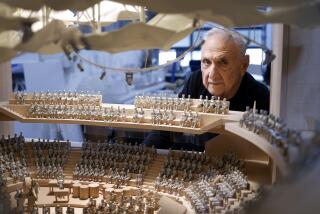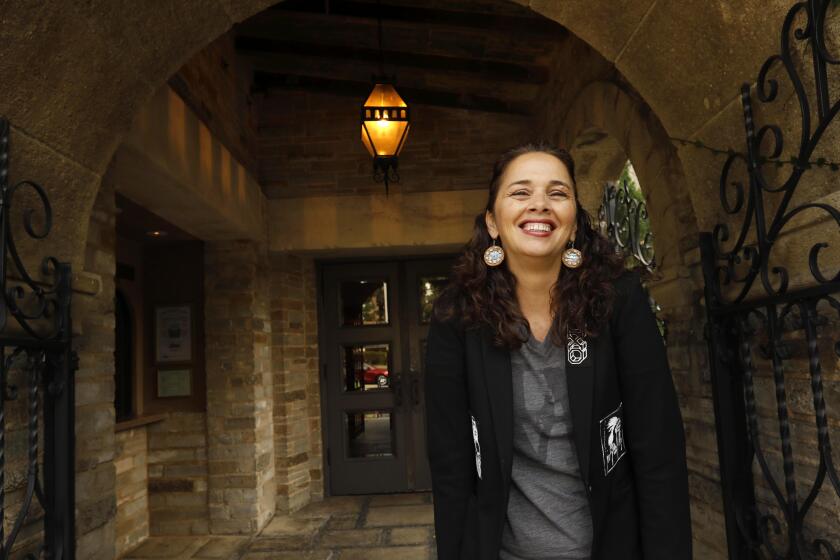Review: The new ‘Empire: The Musical,’ in La Mirada, is more scaffolding than skyscraper
New evidence suggests it’s easier to build the world’s tallest skyscraper than to create an original American musical.
“Empire: The Musical” has just opened at La Mirada Theatre for the Performing Arts. Inspired by the story of the Empire State Building, authors Caroline Sherman and Robert Hull began writing the book, music and lyrics in 1999. By comparison, the Empire State Building itself — all 102 stories of it — was finished after just a year and 45 days, in 1931, in the midst of the Depression.
Of course, the skyscraper was financed from the get-go by industrialists; the musical had to find backers, as well as the director and choreographer Marcia Milgrom Dodge (nominated for a Tony Award in 2010 for her revival of “Ragtime”). Up on its feet at last at La Mirada, the world premiere of “Empire” is billed as “the pre-Broadway engagement.” But how sturdy is this structure, really? (Warning: Architectural analogies will be used heavily in this review, as they are in the musical.)
In this “Empire,” the foundation is wobbly. The framework teeters until intermission, then collapses to rubble in Act 2.
The Empire State Building is a triumph of Art Deco architecture and a metaphor for the ambition and grit of the American spirit. The workers who built it, immigrants as well as Native American Mohawk “skywalkers,” exemplify the dream of diverse cultures unified by a bold common dream — or as one of Sherman and Hull’s lyrics puts it, succinctly if unappetizingly, “a melting pot of ‘can-do.’”
This lavish production summons up the patriotism and pluck of a long-gone America. Its video projections, by Brad Peterson and scenic designer David Gallo, breathtakingly evoke Lewis Wickes Hine’s black-and-white photographs of the Empire State construction site. And they move, sweeping the audience into 3-D tours of 1930s New York City and sending us high up into the vertiginous structure. The actors interact playfully with the images, bending to lower digital beams into place or, down at street level, disappearing through a projected revolving door.
The show reaches its pinnacle late in the first act with the number “Lunchtime,” in which the laborers show off their acrobatic skills on the girders to impress female passersby. The set and projections work together like clockwork; Dodge’s choreography is at its playful and muscular best; Leon Wiebers’ period costumes add individuality and color to the ensemble; the song’s cheeky energy is irresistible.
But people don’t buy tickets to watch a building get built, even if it’s tall. Sherman and Hull may have found a promising backdrop for an American musical, but they’re still searching for the story to set against it and the characters to embody its themes.
Two historical figures, the industrialists/politicians John J. Raskob (Tony Sheldon) and Al Smith (Michael McCormick), depicted as jocular buffoons, are joined onstage by fictional musical-theater tropes. There’s Al Smith’s bombshell of an assistant, the tough-talking “can-do gal” Frankie Peterson (Stephanie Gibson), who holds an undefined but critical position in the construction of the new skyscraper, then known as the Al Smith Building. For some reason she’s annoyed when a handsome young architect, Michael Shaw (Kevin Earley), is hired to design it. He’s a dreamer — his architectural philosophy can be summarized as “going up” — whereas she’s a pragmatist with a gift for greasing wheels. Their spiky rapport is such a tried-and-true form of foreplay that they don’t even bother to display the slightest mutual attraction before abruptly launching into a love duet. (It’s called “Falling Into My Heart,” and because it follows the fatal fall of a construction worker from a high floor, its imagery seems in poor taste.)
A few members of the crew are also given story lines: Ethan O’Dowd (Caleb Shaw), an appealing Irishman whose wife, Emily (Katharine McDonough), fears for his safety at work; Bucky Brandt (Tommy Bracco), who yearns to walk on the high beams with the Mohawk; and a mysterious person who answers to the name Bill Johnson. These three command the wrecking ball of plot twists that ultimately vaporizes the ambitious edifice of “Empire.”
A Playbill article from 2008 about an earlier iteration of “Empire,” said to be eyeing a Broadway run even then, lists the characters: “Michael, a starry-eyed young architect … Hilda, a driven journalist who believes in the good of the people … Gladys, the fast-talking, don’t-mess-with-me contractor who teaches both Hilda and Michael about trade-offs … and Sam, the dedicated laborer with a secret, which, once revealed, will change everyone.”
Most of those people didn’t make it into this draft, but swapping them out hasn’t resolved the problems. The story of the Empire State Building may not lend itself to the kind of musical “Empire” wants to be, in which scrappy dreamers overcome the odds to build an American icon. The skyscraper was the baby of fat cats with the means to truck in tons of steel and marble while much of the country stood in bread lines — and the money to influence politicians, silence protesters and buy off grieving widows.
The Empire State Building had its naysayers, but it reached the sky anyway. “Empire: The Musical” could very well do the same. The show abounds in theatrical imagination, ingenuity and passion. It just needs a plot that can bear the weight.
“Empire: The Musical,” La Mirada Theatre for the Performing Arts, 14900 La Mirada Blvd., La Mirada. 7:30 p.m. Wednesdays and Thursdays, 8 p.m. Fridays, 2 and 8 p.m. Saturdays, 2 p.m. Sundays. Ends Feb. 14. $20-$70. (562) 944-9801 or www.lamiradatheatre.com. Running time: 2 hours, 50 minutes.
More to Read
The biggest entertainment stories
Get our big stories about Hollywood, film, television, music, arts, culture and more right in your inbox as soon as they publish.
You may occasionally receive promotional content from the Los Angeles Times.






